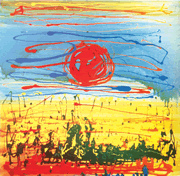
What is the role of fine arts in building a more Christian civilization?
Many consider this to be a key question as Notre Dame enters a new era in the arts with the opening of the DeBartolo Center for the Performing Arts, and it was the central question of “Epiphanies of Beauty: The Arts in a Post-Christian Culture,” a fall conference organized by the Notre Dame Center for Ethics and Culture.
The phrase “Epiphanies of Beauty” comes directly from Pope John Paul II’s Letter to Artists, which says artists can give others a chance to encounter the divine in our increasingly secular world, according to David Solomon, W.P. and H.B. White Director, Center for Ethics and Culture.
This deeper side of beauty goes beyond paintings and stained glass, and touches on creativity in all the arts. Conference discussions centered on a revival of interest in the arts throughout the Catholic Church that is taking place in Europe and Latin America, as well as this country, Solomon said. Topics related to architecture, art history, the visual arts, poetry, literature, film, music, education, philosophy and theology, were explored with papers presented by 122 scholars.
Solomon says the opening of the DeBartolo Center for the Performing Arts has the potential to spark tremendous interest in the arts on the Notre Dame campus.
“When I came here in 1968 as a faculty member, the arts were dead,” he says. "The students were good solid people, but many were not very interested in the arts. The good news is that is changing. The revival in interest in the arts has the potential to be as dramatic as anything Ive seen.
“Most people picture artists as rebelling against religion, but on the contrary, many are discovering the divine through their art. After the conference, one artist told me she couldnt sleep because she was so inspired by what she heard; she couldnt wait to get into her studio.”
Solomon said he was a bit worried about putting on a conference with art as its theme.
“I’m used to working with philosophers and theologians,” he said. “Here we had all these artists.”
But the experience brought together a diverse group, including working painters and musicians, parish priests, lawyers and undergrads, as well as philosophers, and turned out to have the largest attendance of any conference yet, he said. More than 600 attended, demonstrating there is significant interest in this topic.
As a practical response to Notre Dames Catholic mission, the conference provided a meeting ground for artists.
“Some of the artists work alone, and are lonesome, painting from their own spirituality, and they found working friendships with those of similar interests,” Solomon said.
Solomons personal highlight was the honoring of William Schickel, celebrated artist and Notre Dame alumnus, who remains on the cutting edge of art even in his mid 80s.
“He mentioned the inspiration he got from his teachers and the traditions at Notre Dame in the 1940s, and yet he is still daring, still thinking, not bound by the limits of tradition,” Solomon said.
On the topic of literature, Gregory Wolfe, publisher and editor of Image, a journal of the arts and religion, compared the work of contemporary writers with those working in the 1930s and 40s, during the “Golden Age of Catholic Literature,” such as Evelyn Waugh and Graham Greene.
“He said we are experiencing a revival in Catholic writing, and many people might be surprised by that,” Solomon said.
Notre Dame professors and authors Ralph McInerny and Kevin Hart spoke on their approach to their literary and poetic works.
Another highlight was the talk by Alasdair MacIntyre, research professor of philosophy, on “What Makes a Painting a Religious Painting?” by comparing the works of El Greco and Mark Rothko.
The conference also featured presentations on architecture and urban design featuring Philip Bess, Thomas Gordon Smith and Duncan Stroik of Notre Dames School of Architecture. Diana Matthias of the Snite Museum, led tours of the Snites collections.
A musical highlight was the performance of Oliver Messiaens “Visions de lAmen.” The two-piano performance and a lecture by Stephen Schloesser of Boston College, explored Messiaens connections to French Catholic Revivalism.
“Epiphanies of Beauty” was one of several conferences this fall that addressed the issue of Catholicism and spiritual influences across multiple disciplines. “Faith, Ethics and Environment: The Response of a Catholic University” in early November assembled theologians, ethicists, scientists and environmentalists to explore the ways a Catholic university can respond to environmental challenges facing society.
Earlier, leading ethicists, engineers, economists and energy industry decision makers gathered for a conference titled “Ethics and Changing Energy Markets: Issues for Engineers, Managers and Regulators.” A discussion, " Notre Dame: What’s Next?" ** sponsored by the College of Arts and Letters under the auspices of the Erasmus Institute, featured a panel of scholars who discussed the idea of the Catholic college.
TopicID: 8281